PROTECT YOUR DNA WITH QUANTUM TECHNOLOGY
Orgo-Life the new way to the future Advertising by AdpathwayDeadly Lessons shows young cheetahs that have caught a Günther’s dik-dik in Samburu national reserve, Kenya. Marina Cano, from Spain, was highly commended in the mammals’ behaviour category for her shot of the three practising their hunting skills while their mother looked on.
Photograph: Marina Cano/2025 Wildlife Photographer of the Year
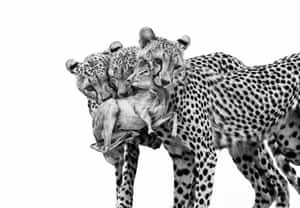
Nature Reclaims Its Space shows fruit bats leaving their roost in the ruins of a historical monument in Banda in India’s Maharashtra state. To take the photo, Sitaram Raul, from India, worked in total darkness, manually focusing his lens at the distance where he guessed the bats might appear and relying on flash to illuminate the scene.
Photograph: Sitaram Raul/2025 Wildlife Photographer of the Year

Pink Pose shows a greater flamingo scratching its head in the Camargue wetlands of southern France. Leana Kuster, from Switzerland, was highly commended in the 15 to 17 years competition for the photo, which was taken while she was on holiday watching them forage in the shallow brackish water for molluscs and crustaceans.
Photograph: Leana Kuster/2025 Wildlife Photographer of the Year
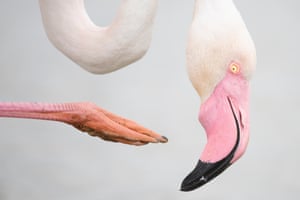
Jelly Smack Summer shows a bloom, or smack, of Pacific sea nettle jellyfish in Monterey Bay, California. To take the photo, Ralph Pace, from the US, smeared petroleum jelly on any skin not covered by his wetsuit. Despite their name, their sting is more like that of a bee than a nettle, Pace says. Highly adaptable to warming seas, jellyfish are appearing in larger numbers.
Photograph: Ralph Pace/2025 Wildlife Photographer of the Year
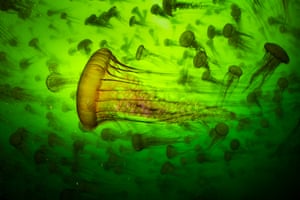
A Tale of Two Coyotes shows the wolf-like canid in San Francisco’s Bernal Heights Park. Parham Pourahmad, from the US, followed a pair for hours to capture this image, highly commended in the 11 to 14 years section. About 100 of the highly adaptable animals now live in the city.
Photograph: Parham Pourahmad/2025 Wildlife Photographer of the Year
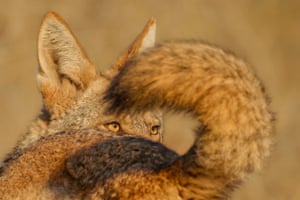
Toxic Tip shows a solitary Asian elephant navigating a waste-disposal site in Ampara, Sri Lanka. Lakshitha Karunarathna has documented human–elephant conflict in his country for more than three years. About 20 elephants have died over eight years at one of two open rubbish tips in the town after consuming food wrappers and other plastic waste as they foraged there.
Photograph: Lakshitha Karunarathna/2025 Wildlife Photographer of the Year
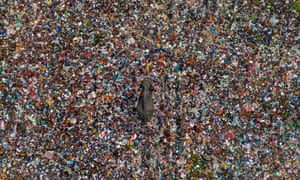
Slime Family Portrait shows mould on a tree in Slindon Wood, West Sussex. Taken by Kutub Uddin, from Bangladesh and the UK, it shows the blueberry-like reproductive parts of a slime mould – a single-celled, amoeba-like organism – each just 1–2 millimetres wide, next to an insect’s tiny yellow egg.
Photograph: Kutub Uddin/2025 Wildlife Photographer of the Year
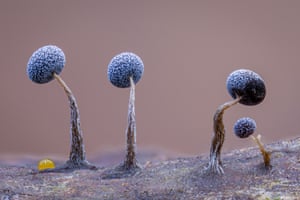
Essence of Kamchatka shows a brown bear in Russia’s far east as a slaty-backed gull flies past. Taken by Kesshav Vikram, from India, it was highly commended in the 11 to 14 years category. Vikram waited days for the bear to stroll along the shore of Kurile Lake to feast on a glut of sockeye salmon migrating upriver to spawn.
Photograph: Kesshav Vikram/2025 Wildlife Photographer of the Year
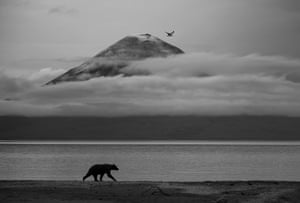
Ice Edge Journey shows an emperor penguin colony on the Ekström ice shelf, in Atka Bay, Antarctica. It was taken by Bertie Gregory, from the UK, who saw most of the fledgling chicks using ice ramps to enter the sea to hunt for food. But this group missed the easy way down and took a 15-metre (50ft) leap into the water. Scientists say the decline of sea ice in Antarctica may force more penguins to breed on ice shelves, making this behaviour increasingly common in the future.
Photograph: Bertie Gregory/2025 Wildlife Photographer of the Year
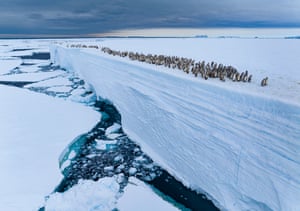
No Place Like Home shows a brown-throated three-toed sloth clinging to a fencepost in Costa Rica, taken by Emmanuel Tardy, from France. As their habitat disappears, sloths are forced to travel farther on the ground. The Costa Rican government is now working with conservation organisations to establish wildlife corridors, including aerial bridges, that reconnect their forest habitat.
Photograph: Emmanuel Tardy/2025 Wildlife Photographer of the Year
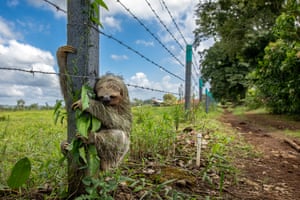
Wake-up Call shows a lion and cobra in Tanzania’s Serengeti national park. It was taken by Gabriella Comi, from Italy, after she and a guide spotted a cobra slithering towards two sleeping lions. Within seconds, the eldest of the pair was facing down the venomous intruder. The Serengeti is renowned for its large population of lions, with about 3,000 there.
Photograph: Gabriella Comi/2025 Wildlife Photographer of the Year
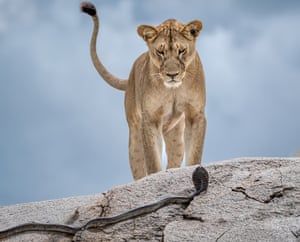
Clouds of Gold shows the salt ponds that border San Francisco Bay. Taken from his light aircraft by Jassen Todorov, from the US, it reveals how the South Bay salt pond restoration project has removed artificial dykes to recreate tidal marsh habitats, allowing salt-tolerant plants and wildlife to flourish once more.
Photograph: Jassen Todorov/2025 Wildlife Photographer of the Year
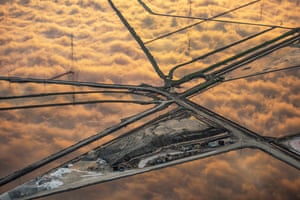
Rutting Call shows a red deer stag in Bradgate Park, Leicestershire. Taken by Jamie Smart, from the UK, it was highly commended in the under-10s category. She had to stretch up to avoid the long grass in the foreground spoiling her shot.
Photograph: Jamie Smart/2025 Wildlife Photographer of the Year
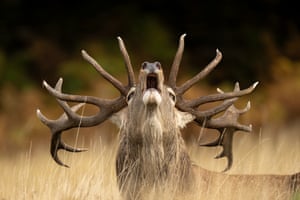
Inside the Pack shows Arctic wolves on Ellesmere Island in Canada. Taken by Amit Eshel, from Israel, in temperatures of -35C (-31F), it shows the elusive wolves coming close enough for him to smell their breath. Restricted to Canada’s most northern territories and northern Greenland, the white subspecies of the grey wolf are curious about humans due to a lack of familiarity.
Photograph: Amit Eshel/2025 Wildlife Photographer of the Year
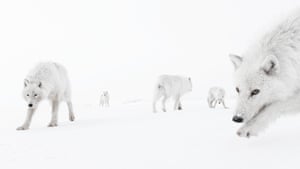
Fragile River of Life shows a female longnose gar pursued by several males in a Florida river during the mating season with a diamondback terrapin above them. Taken by Isaac Szabo, from the US, the river in Columbia county is one of more than 1,000 waterways fed by freshwater springs renowned for their clarity. Maintaining the aquifers that supply these springs is vital not only for wildlife such as manatees, but also for providing drinking water to nearly half of Florida.
Photograph: Isaac Szabo/2025 Wildlife Photographer of the Year
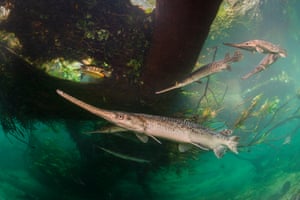


 2 days ago
21
2 days ago
21

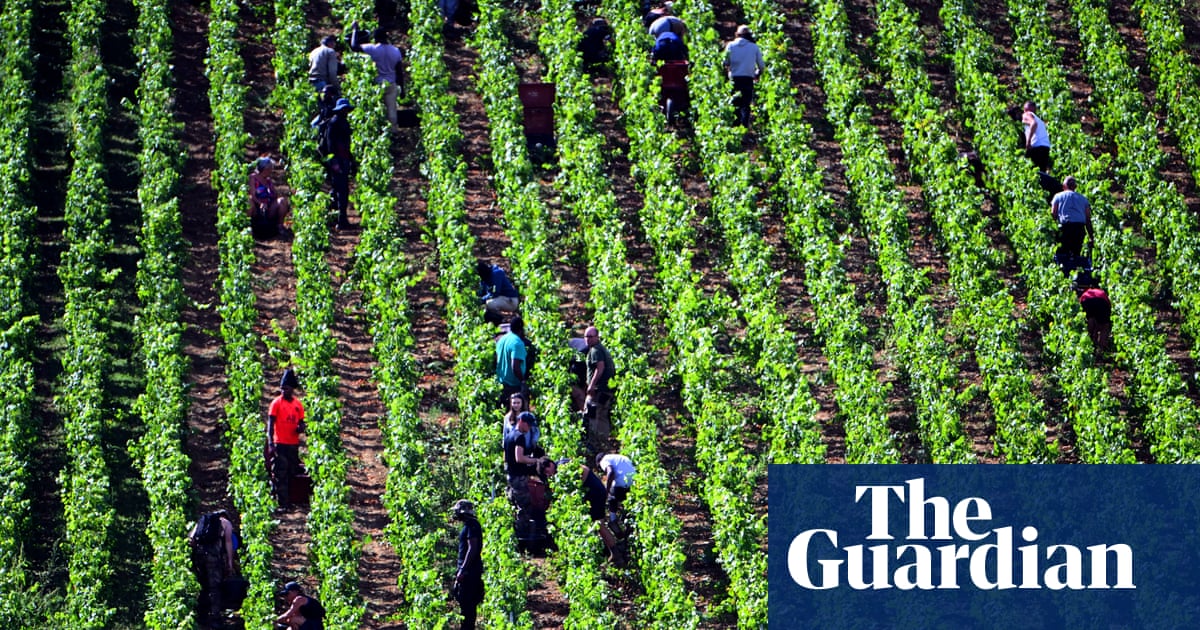


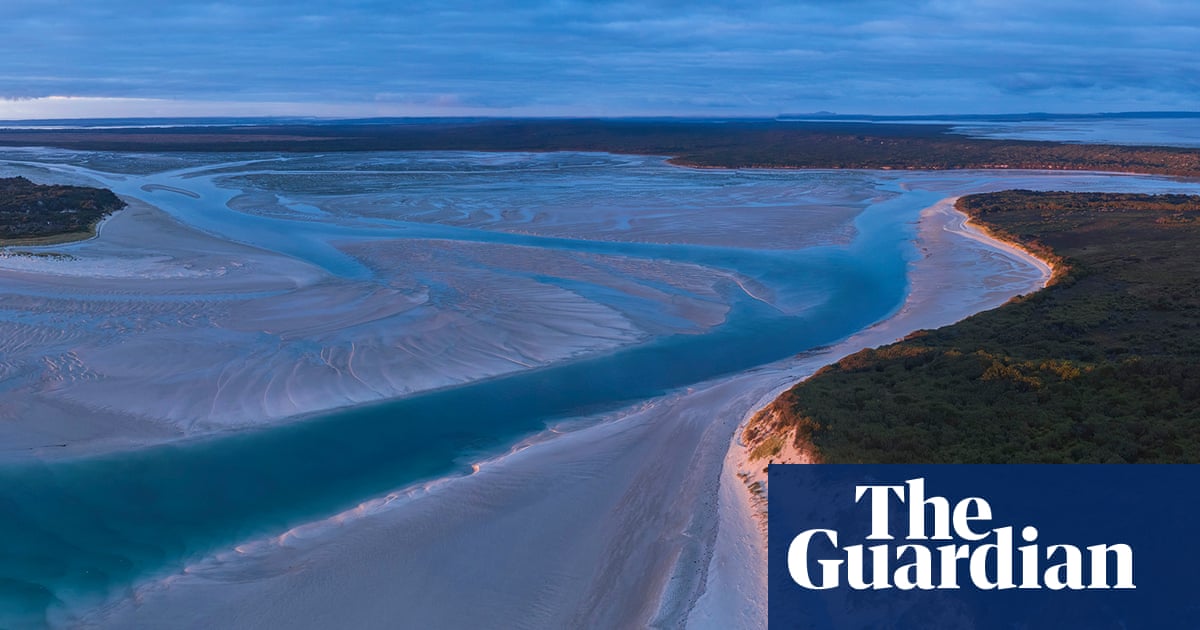
















 English (US) ·
English (US) ·  French (CA) ·
French (CA) ·